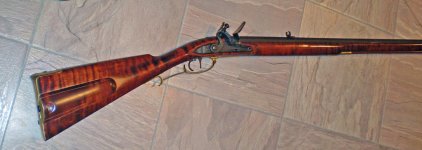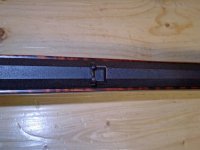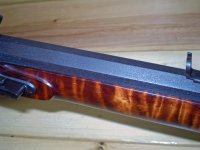2152hq,
this question might really be for you since it was you on this forum that led me to try a bottle of Laurel Mountain Barrel Brown and Degreaser and use it in a rust blue treatment. I used it this past summer during our "rainy season" ( I'm in AZ) and thought it worked very well for me on a revolver I had finished with a blasted surface. At least with that gun's particular steel and the blasted surface, the color took really fast, even, and seemed to be more blue-black and much less grey than the Pilkington's solution I had used on several other guns. I attempted to take a digital picture of one blasted gun using Pilkington's and the another using Laurel Mountain but the difference could not really be seen. With the guns in hand, I think the Laurel Mountain looks better in color. Of course, the two guns were not of the same maker and it is most likely the steel is different in the two.
In the Laurel Mountain instructions, it is noted that the polishing can be finished up with 400 to 800 grit. This is markedly different than Pilikington's instructions where it is said to go no finer than 320 grit. I have also read in Chicoine's Gunsmithing book to finish up with 320 grit. I am polishing another S&W right now and intend to use the Laurel Mountain solution. Can you, 2152hq, or anyone else comment on the advisability of going finer than 320 grit? I do intend to use a humidity tent this time as it has dried considerably here.
Dan
this question might really be for you since it was you on this forum that led me to try a bottle of Laurel Mountain Barrel Brown and Degreaser and use it in a rust blue treatment. I used it this past summer during our "rainy season" ( I'm in AZ) and thought it worked very well for me on a revolver I had finished with a blasted surface. At least with that gun's particular steel and the blasted surface, the color took really fast, even, and seemed to be more blue-black and much less grey than the Pilkington's solution I had used on several other guns. I attempted to take a digital picture of one blasted gun using Pilkington's and the another using Laurel Mountain but the difference could not really be seen. With the guns in hand, I think the Laurel Mountain looks better in color. Of course, the two guns were not of the same maker and it is most likely the steel is different in the two.
In the Laurel Mountain instructions, it is noted that the polishing can be finished up with 400 to 800 grit. This is markedly different than Pilikington's instructions where it is said to go no finer than 320 grit. I have also read in Chicoine's Gunsmithing book to finish up with 320 grit. I am polishing another S&W right now and intend to use the Laurel Mountain solution. Can you, 2152hq, or anyone else comment on the advisability of going finer than 320 grit? I do intend to use a humidity tent this time as it has dried considerably here.
Dan















